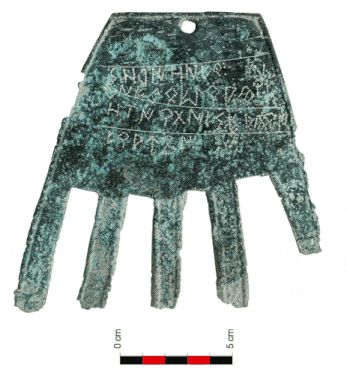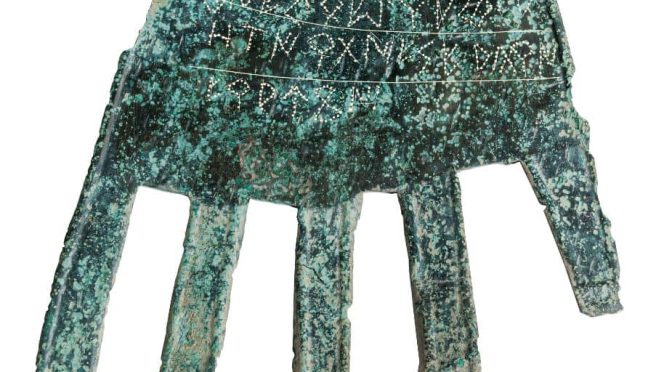On Monday, my feeds blew up. A new discovery – a bronze relic dating back some 2100 years – shook the Basque world. This relic – of a hand, likely an amulet of good fortune – had words written on it in (an ancestor to) Basque in a unique runic script. This discovery – the Hand of Irulegi – upends our understanding about the history of Euskara, showing that the ancestors of the Basques were writing their language before the Romans came and introduced Latin.

- The hand was discovered by the Aranzadi Zientzia Elkartea (Aranzadi Science Society) during excavations of an old house at the historical site of Irulegi, in Nafarroa near Pamplona/Iruña. Irulegi was originally settled between 1600 and 1400 BCE and peaked in size around the 1st century BCE. It was then burned to the ground during the Sertorian War by Pompey’s forces, freezing it in time and giving us a time capsule to this ancient Basque city. The Aranzadi Science Society has been excavating the region, led by Mattin Aiestaran, since 2017.
- Strictly, the peoples who inhabited Irulegi back then were the Vascones, a pre-Roman tribe considered to be ancestors to our modern Basques.
- The hand was discovered on June 18, 2021, by Leire Malkorra but it wasn’t until January 18, 2022, that Carmen Usúa, a restorer for the Government of Navarra, discovered the text inscribed upon its surface. Javier Velaza and Joaquín Gorrochategui then interpreted the text. Scientists at Uppsala University in Sweden dated the hand to the 1st century, BCE.
- The hand itself is made of bronze and measures about 5.5 inches by 5 inches. It is only about 1 millimeter thick. It has a hole near the wrist, indicating it was likely nailed to a wall or something similar.
- The hand has five words inscribed upon its surface. The first word is “sorioneku” which means “good fortune” and is very clearly related to the modern Euskara zorioneko. The meaning of the rest of the words – there are five in total – is less clear. The words were written into the bronze by both inscribing and by stippling (dotting), a unique combination not usually found.
- The find pushes the historical record of written Basque back more than 1000 years. It shows that the Basque speakers were literate, with their own script, before the Romans reached the region. They adapted an Iberian runic script to their own needs, including adding the symbol ‘T.’
- Before this, the oldest words in Euskara were names, not texts, that were written in the Latin script, dating back to the 2nd and 3rd centuries. The previous oldest text, with true words, was much younger: the Emilian Glosses dating back to about 950.
- As Alistair Dodds emphasizes, this is a massive breakthrough in the history of Euskara. It rewrites our understanding of how Euskara was used more than 2000 years ago, showing that Basque speakers were literate and were writing their language before the Romans and Latin arrived in the region. They were using their own script! This upends the previous theory that the Basques never wrote their language until Latin was introduced to the region. How cool is this?!?
- If you speak Euskara, this video provides more context and details about the discovery of the Hand of Irulegi.
Primary sources: La escritura en la mano by Eider Conde-Egia, Aranzadi Zientzia Elkartea; La Mano de Irulegi: descubierto el texto más antiguo en ‘euskera’ by Josu Álvarez De Eulate, Noticias de Navarra; Researchers claim to have found earliest document written in Basque 2,100 years ago by Vicente G. Olaya, El Pais; This 2,000-Year-Old Inscription Changes Our Understanding of the Basque Language by Sara Kuta, Smithsonian Magazine
Discover more from Buber's Basque Page
Subscribe to get the latest posts sent to your email.



I want to learn more!
As do I! Some of the links give more details, but I think they are still trying to understand what all of this means and what the rest of the writing on the relic means.
Aupa!
I am making a replica of the Irulegi Hand as a gift for a friend in Durango. It is an interesting craft project. I’ll send a photo when it is done. Agur!
Very cool! Yes, please do share a photo when you are done!